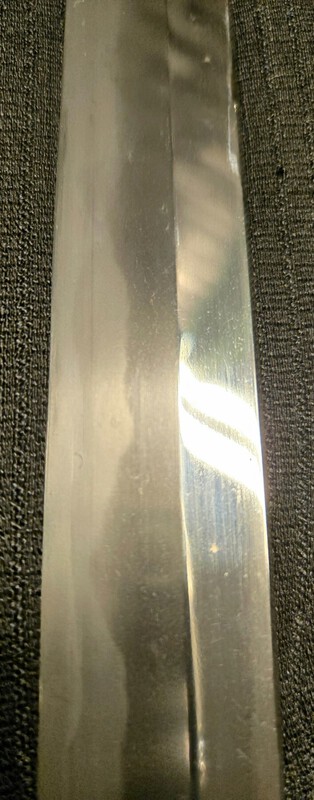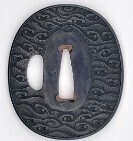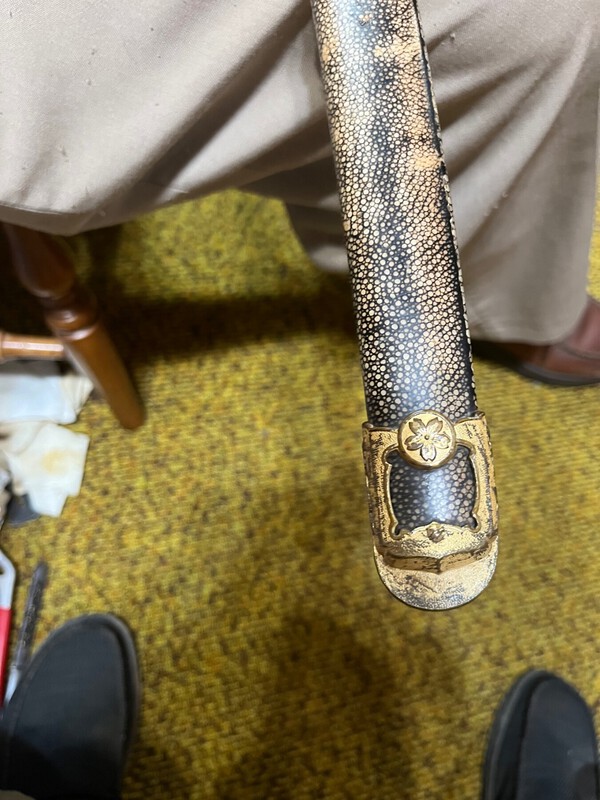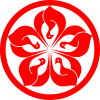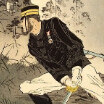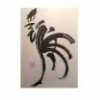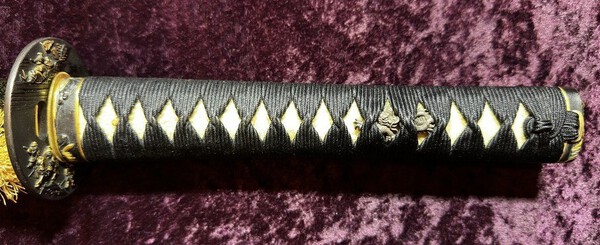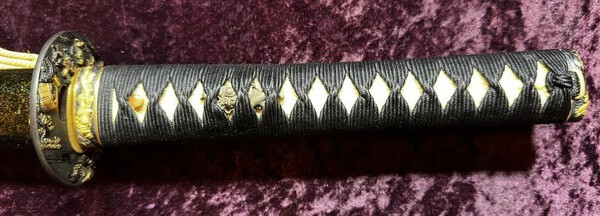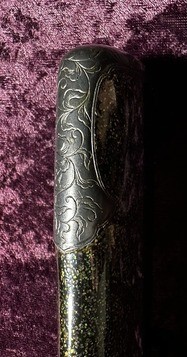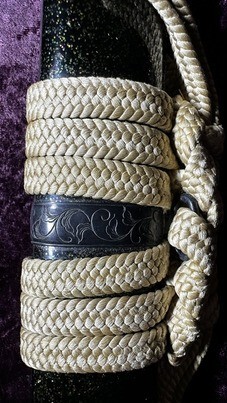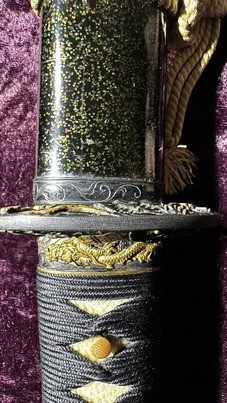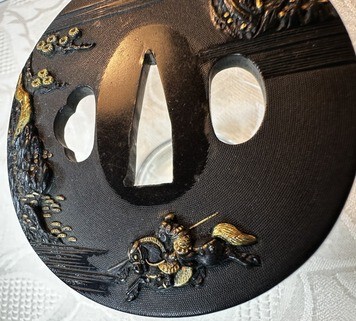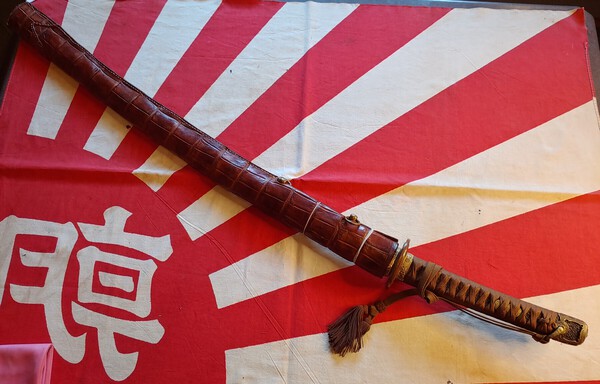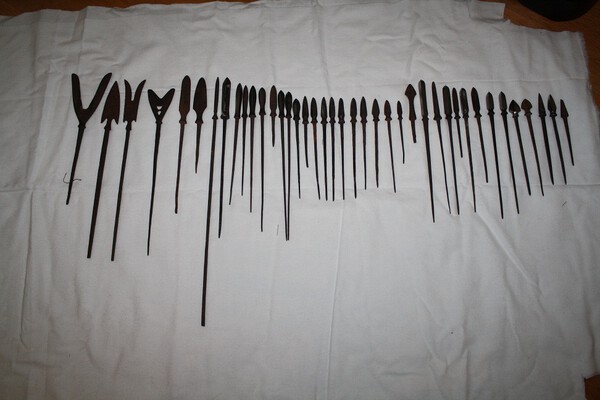Leaderboard
Popular Content
Showing content with the highest reputation on 06/04/2025 in Posts
-
陸奥守綱宗 – Mutsu no kami Tsunamune A real daimyo who enjoyed making swords. Ref. Date Tsunamune - Wikipedia5 points
-
Welcome Alves. I believe your tsuba is by the Shoami school, [someone may come in with a translation of the signature] Aoi-tachi-mokko shape? Or at least tachi style. Mandarin Mansion says, Tachi-mokkō-gata (太刀木瓜形) literally means "Tachi cross shape". This style of tsuba was since ancient times mounted on tachi (太刀), large swords that were worn edge downwards, slung from a belt, mainly by cavalry. It is also known as aoi-gata (葵形) or "hollyhock shape". The style dates back to Tachi swords but continued as a formal shape fitted to Katana blades - tachi did not have the hitsu-ana [holes for kozuka and kogai] originally, though many tachi tsuba had the holes cut in later. Alves, yours is made at a time for a Katana from the design and the direction of the nakago-ana [tang hole]3 points
-
The black writing says 権之丞寫 (Gonnosuke utsushi), meaning "copy of Gonnosuke". Gonnosuke is a name, but I'm unsure if it is an historical figure or fictitious character. There is a Gonnosuke who fought Miyamoto Musashi, but the clothing of the figures in this picture look as if they predate Musashi's time. I haven't cracked the red artist's seal yet.3 points
-
Hi Bruno, Thank you for sharing your piece with us. Your new piece seems quite nice. Congratulations. From examples I have seen, and those shared in this thread, the Yoshihisa lineage was quite accomplished and produced very nice pieces. While I collect mainly Echizen Kinai, I do have some pieces from other schools active in the Echizen region, including Myochin and Akao. Here are a few of the Myochin pieces in my collection. Note that sometimes signed Esshu and sometimes Echizen, but my understanding is both originate in Echizen. I hope these help with your research. Damon3 points
-
Doing nothing more that scanning the images in the old Sendai-han Mei kan, your nakago seems unlike the ones shown. Obviously that makes in suspicious to me. It certainly is interesting and deserves research. Peter2 points
-
Coz it’s upside down? Kashū Jū 橘 Tachibana Katsu…. (Cut off)(?定 -sada?)2 points
-
True, and I think it could have been a valuable discussion. I guess my point was that anything worth while is a needle in a haystack now. Here I am, not helping that situation . In hindsight, I should not have interjected. I re-read this today, it’s a good write up and very interesting. https://markussesko.com/2016/01/20/cast-sword-fittings/ -Sam2 points
-
2 points
-
2 points
-
2 points
-
Hello Salvatore, What do you wish to know? This is a very straight wakisashi, in not so bad condition, genuine nihonto. Maybe end of muromachie or begining Momoyama kanbun shinto. If you want to know if the meï is good, you will have to do a little research... Difficult to say. Best, Eric2 points
-
Yes, we have to get used to the fact that when we say "arsenal" or "machine made" or Showato etc etc, we mean not 100% traditionally made, and likely oil quenched. They were still made by a smith, could be forged and hammered (power or otherwise) but not considered Gendaito. Handmade? You could say that. But on a mass production and fast basis, and oil quenched. When we say Gendaito, it used tamahagane, and was water quenched. Excluding those odd swords that fall somewhere in the middle. But this one is oil quenched, and the stamp is a clear indicator that it is not a Gendaito, whether it would paper or not.2 points
-
In this context, handmade traditional sword-blades are understood to be made from TAMAHAGANE. The steel of these would have been purified by forging, folding, and fire-welding a number of times before being forged out to its final shape. Traditional quenching in water and polishing without machines would follow. This applies to GENDAITO and SHINSAKUTO. There is no rule about the use of a power-hammer: You still have to hold the blade and guide the action, so this is not considered as "machine-made". It all depends on the situation in your forge: If you have no apprentices, the power-hammer will help with the raw work. There were several methods to produce wartime blades. SHOWATO are made from industrial steel without folding and fire-welding. As far as I understand, there are rare exceptions to this. Modern alloyed steel cannot be water-quenched without a high risk of cracking. Oil-quenching generates a good hardness with little risk of KIZU, but does not produce HATARAKI in the steel as we see them on traditionally made blades. There will be no NIE formations, and the HAMON is rather plain and without much variation. If you compare a traditional blade and a SHOWATO side by side, this will be obvious. What you like and find interesting is a matter of personal preference and taste.2 points
-
Type (Tachi, Katana, Wakizashi, Tanto, Naginata, Other) : Sunobi Tanto Mei : (Mumei, Signature) : None - attributed to Uda Kunihisa Papered or not and by whom? : NBTHK Hozon and NBTHK Tokubetsu Kicho Era/Age : Late Nanbokucho Shirasaya, Koshirae or Bare Blade? : Shirasaya + Koshirae Nagasa/Blade Length : 32.6 cm (12.83 in) Sori : 0.0 cm (0.0 in) Flaws : None Sword Location : New York, United States Will ship to : Open to anywhere that allows Payment Methods Accepted : Wire Price and Currency : $4250 USD Other Info and Full Description : Hi Fellow Collectors! I have a Sunobi tanto from the late Nanbokucho period up for sale. Comes with a full shirasaya and koshirae set, and has two NBTHK Papers. The more recent hozon papers attribute the blade to Uda Kunihisa, who is said to have been the son of Kunimune, and there were several generations of the same name from Oei to the end of the Muromachi period. The dragon and kanji horimono are intricate and well carved. Blade is in excellent condition with no flaws. You can find a full set of pictures and a verification picture with today's date and my name on it and HD images in the link here: https://drive.google.com/drive/folders/1m2Q2wJBbKIlF_5N3RHMRYZONAr5isCrP?usp=sharing Blade is located currently in the US but willing to ship anywhere that can clear customs. Send me a message with any questions or interest!, am open to any reasonable offers as well!1 point
-
I have two tsuba. Priced to go, prices include shipping. 1. Tosho tsuba I hope pictures will tell it all. A large (8.5 cm) tosho tsuba, possibly early Edo, maybe earlier (although orthodoxy will tell you otherwise because of the thickness). Measurements: 8.45 x 8.2 cm thickness at rim: 3.5 mm Great for mounting or just enjoying. EUR 150 including shipping to EU and US 1. Iron tsuba Tiny gold remnants on this one, nice shape, heavy in hand, shakudo plug. Measurements: 7.6 x 7.25 cm thickness at rim: 6 mm at seppa dai 5mm EUR 100 including shipping to EU and US1 point
-
1 point
-
1 point
-
1 point
-
Of course, I'm keeping it as it is. I just try to make the photos better. Thank you for your interest and your comment!1 point
-
Looks like it was crudely added later and hidden beneath seppa.1 point
-
Sirs, I'm just starting up my Japanese arrow renovation project. I have plenty of arrows needing fletching as well as new arrowheads. When I made a survey I noticed that among the hundred or so arrows there are at least 20 different birds contributing to the existing feathers. I would be interesting to now what birds since I'm trying to get the original feathers ( there are legal ways even though they are protected) If there are there any ornithologists or bird lovers out there that can intentify enclosed feathers it would be great. I found this list of Japanese birds of pray, anyone able to connect that to the photos? Osprey Pandion haliaetus Misago Honey Buzzard (or Eurasian Honey Buzzard) Pernis apivorus Hachikuma Black Kite Milvus migrans Tobi White-tailed Eagle Haliaeetus albicilla Ojiro-washi Steller's Sea Eagle Haliaeetus pelagicus 0h-washi Northern Goshawk(or Goshawk) Accipiter gentilis Oh-taka Grey Frog Hawk Accipiter soloensis Akahara-daka Japanese Sparrowhawk Accipiter gularis Tsumi Sparrowhawk (or Northern Sparrowhawk) Accipiter nisus Hai-taka Rough-legged Buzzard( Rough-legged Hawk) Buteo lagopus Keashi-nosuri Upland Buzzard Buteo hemilasius Oh-nosuri Common Buzzard (or Buzzard) Buteo buteo Nosuri Grey-faced Buzzard-Eagle Butastur indicus Sashiba Hodgson's Hawk-eagle(Mountain Hawk Eagle) Spizaetus nipalensis Kuma-taka Greater Spotted Eagle(or Spotted Eagle) Aquila clanga Karafuto-washi Imperial Eagle Aquila heliaca Katashiro-washi Golden Eagle Aquila chrysaetos Inu-washi Cinereous Vulture Aegypius monachus Kuro-hagewashi Crested Serpent Eagle Spilornis cheela Kanmuri-washi Northern Harrier(or Hen Harrier, Marsh Hawk) Circus cyaneus Haiiro-chuhi Pied Harrier Circus melanoleucos Madara-chuhi Eastern Marsh Harrier Circus spilonotus Chuhi Family Falconidae English Names Scientific Names Japanese Names Gyrfalcon Falco rusticolus Shiro-hayabusa Pregrine Falcon Falco peregrinus Hayabusa Northern Hobby(or Hobby) Falco subbuteo Chigo-hayabusa Merlin Falco columbaris Ko-chougenbou Eastern Red-footed Falcon Falco amurensis Akaashi-chougenbou Lesser Kestrel Falco naumanni Hime-chougenbou Eurasian Kestrel(or Kestrel) Falco tinninculus Chougenbou Family Strigidae English Names Scientific Names Japanese Names Snowy Owl Nyctea scandiaca Shiro-fukurou Eurasian Eagle Owl(or Eagle Owl) Bubo bubo Washi-mimizuku Blakiston's Fish Owl Ketupa blakistoni Shima-fukurou Long-eared Owl Asio otus Torafu-zuku Short-eared Owl Asio flammeus Komimi-zuku Common Scops Owl(or Scops Owl) Otus scops Konoha-zuku Elegant Scops Owl Otus elegans Ryukyu-konohazuku Collared Scops Owl Otus bakkamoena Oh-konohazuku Borel Owl(or Tengmalm's Owl) Aegolius funereus Kinme-fukurou Brown Hawk Owl Ninox scutulata Aoba-zuku Ural Owl Strix uralensis Fukurou Arrow nr 1 is supposed to be white hawk "shira taka" not on the list, maybe a sub spicies?1 point
-
Post some more photos, close-ups and other side. Also search up the terms that Dale mentioned. There will be a lot of info in other threads on the board.1 point
-
My initial instinct was that this was a modern copy. I’m glad to have been wrong 😀1 point
-
I haven’t found a lot of AI model’s OCR capabilities sufficient enough to read Mei and provide much meaningful output with the rare exception of very crisply cut dates with high resolution photos. I’ve tested most of the popular models even trying to roughly translate juyo descriptions and many details are lost in translation. This may all change weeks or months from now.1 point
-
Thanks, Bruce. 16092 is now logged under Leo Munson. BTW, second to the oldest on file. Still seems likely only 17,000 were produced. John C.1 point
-
This is a first for me, Moriyama San. Thank you! I have a tanto made by the daimyo Date Munetada of Uwajima, so it is interesting for me to discover this background information, an earlier daimyo artist and maker of swords in the wider Date family. Date Munetada - SamuraiWiki1 point
-
The "Backyard Blacksmith" has a range of designs - https://www.jauce.com/user/CAWaKufXrxBdNGAA4UXmvfeWjVRf?search=tsuba - he has put up his prices from his usual 8,000 yen! He may make designs to order?1 point
-
1 point
-
Oops! Yeah that's what I was looking for. Trying to rock the 2mo. old granddaughter and keep her from wailing, and search NMB at the same time! I'll get back over to his house some day, not to far in the future, and update.1 point
-
1 point
-
1 point
-
1 point
-
Agreed. And additionally if the tang isn't already marking the inside of the tsuka where it binds, you could usefully put a little graphite (soft pencil lead) on the tang before you insert it, which will rub off on the tsuka where it binds, allowing you to see the high spots1 point
-
Nikki, The stamp at the top, "Seki", was used between 1940 and 1944, with most dated blades showing up in 1942, just to narrow down the date range for you. It was a quality inspection stamp used by the civil industry to weed out poor blades. The Seki Cutlery Manufacturers Association stamped approved blades, like this one. Such blades were usually really good quality, though not fully traditionally made - called showato.1 point
-
i usually don't list much online, i do most face to face at shows. But someone asked about buying a "real" but inexpensive sword so i showed a few on that thread. i did not hear any follow up so i will list them in case anyone is interested each is a genuine antique nihonto but they are in rough condition hence the lower price thanks for looking1 point
-
1 point
-
It appears to be a modern reproduction. Here is a helpful link: https://www.jssus.org/nkp/fake_japanese_swords.html IMHO, All the best, -Sam1 point
-
Hi Craig! As you suspected, it is a Chinese fake. Signs: The Chinese fakes like to use serial numbers on the habaki (brass collar on blade), writing on the blade, and Damascus steel. Also, they make the folds of the handle wrap all turn in the same direction, while Japanese alternate directions in their wrap folds.1 point
-
Typical Type 98 with non-traditional Showa-to by one of the well regarded Gendai Tosho of the period, nothing really exciting apart from the condition.1 point
-
First of all thanks to all those who looked, especially to Brian for the honesty in his replies. Next, Colin has the correct answer. They are all fakes. Nos.1, 2, 4 and 5 are dark resin. No. 3 is a striped wood, possibly ebony (?). In the bottom row, No. 9 is resin and No. 10 is some kind of crudely-carved green soapstone. Nos. 6 & 7 are possibly boxwood, but you'll see tables covered in these. Their freshness and the identical beady black eyes give them away at once. No. 8, the egg-shaped Asterix-like warrior figure is also that same stripy ebony (?), and the himotoshi holes are up by his neck, in totally the wrong place. Of the two ebony figures, (3&9) the one carrying the sack has a signature plaque underneath which will fool a lot people. "If it's signed, it's surely got to be real." These shell cartouche signature plaques often look similar. The names are Japanese-looking signatures, scrawled for illegibility, and often dyed red. If a Netsuke is looking up at you and cute or smiling, it was probably carved appealingly for the post-Meiji Western tourist market. Most of the features above are immediate tell-tale warnings. (Unfortunately the forger's art progresses.) Apologies for the diversion. I kept a box of these NLO for just such an occasion, and felt a need to get this subject in the open and out of the way. (Photos supplied regarding any of the above points.) Please feel free to add to this thread for the benefit of us all!1 point
-
特製 Tokusei in Japan means 'specially made' and it looks typical to me. Perhaps someone here will recognize the logo mark of the workshop or factory?1 point
-
Nicolette, as noted above it is a WW2 blade by a Seki smith called Kanefusa. You can find a summary of him and the context in NMB Downloads as "Japanese SWORDSMITHS IN GIFU 1937. Go to top of page bar, Downloads, Member Articles. Looks like the only part of the fittings that is original is the wooden saya with the suspension ring. The cane wrap is later.1 point
-
Yes, this is a showa era blade by the 23rd generation Seki Kanefusa. https://www.google.com/search?q=Seki+23rd+kanefusa+site%3Awww.militaria.co.za&client=ms-android-google&sca_esv=a919800cb6345d20&sxsrf=AE3TifPU7yf-CDYn22HMLRmOtiL6qHEU7Q%3A1748896200549&ei=yAk-aIiVIciqwbkP09OJ0QM&oq=Seki+23rd+kanefusa+site%3Awww.militaria.co.za&gs_lp=EhNtb2JpbGUtZ3dzLXdpei1zZXJwIitTZWtpIDIzcmQga2FuZWZ1c2Egc2l0ZTp3d3cubWlsaXRhcmlhLmNvLnphSOM0UKAPWPUncAB4AJABAJgBmAGgAacHqgEDMy41uAEDyAEA-AEBmAIAoAIAmAMAiAYBkgcAoAfoArIHALgHAMIHAMgHAA&sclient=mobile-gws-wiz-serp1 point
-
Meantime, to kickstart this thread, here is a netsuke. It is quite representative of Netsuke in general, a little small perhaps, and the only reason I have chosen this one is that it is my latest find. (And I like it.) Unsigned, it is probably carved from 'tsuge' 柘植, 黄楊, 樿 etc., boxwood, for which there are various Kanji. Buxus microphylla var. Japonica. The carving is finely done, and the netsuke is a pleasure to hold in the hand. There are no added himotoshi holes, this netsuke taking advantage of the natural gaps between the stems of the mushroom branch through which to pass the strings. (Re Himotoshi. Himo 紐 means string/cord, and 通し toshi is part of the verb 通す tosu, to pass through. Short for himotoshi-ana, or 'string-threading holes'.) What would once have hung from this possibly seasonal Netsuke? Quite realistically carved, I can imagine that it might stimulate the taste buds of a Japanese person. Photos follow Can be enjoyed from any angle.1 point
-
1 point
-
Maybe you need to tell people you are a beginner and ask for gentleness before you pose your question.(?) e.g. “Genuine question here, but…” etc. For example your question above, after a sale has gone through, might seem to be a subtle criticism, throwing doubt at the seller as if you know more than them. When people are confused by your motivation in asking the question, they might chose a confused face.1 point
-
1 point
-
1 point
This leaderboard is set to Johannesburg/GMT+02:00


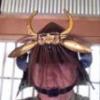
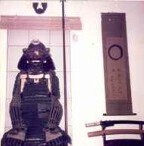

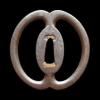




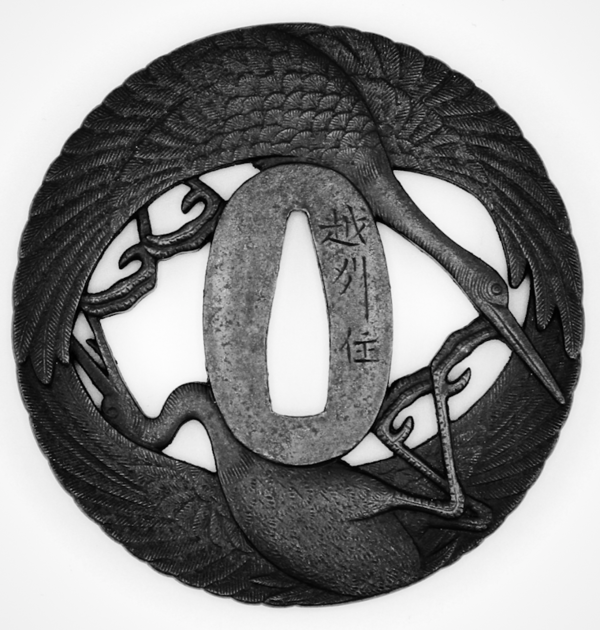

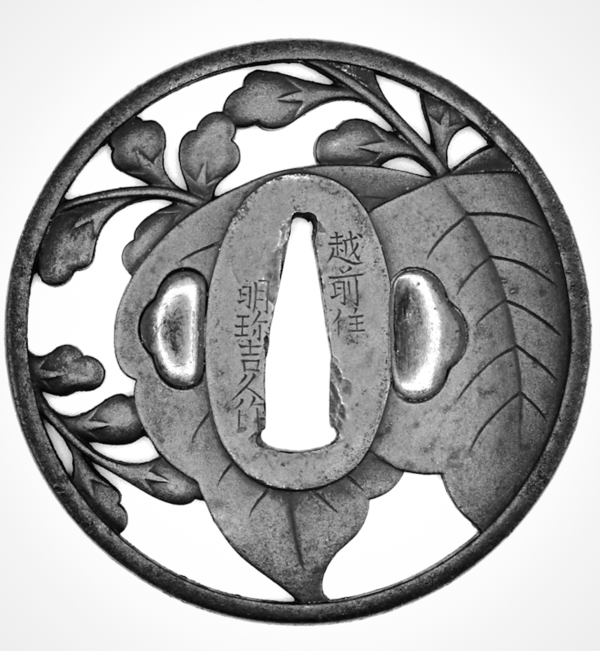





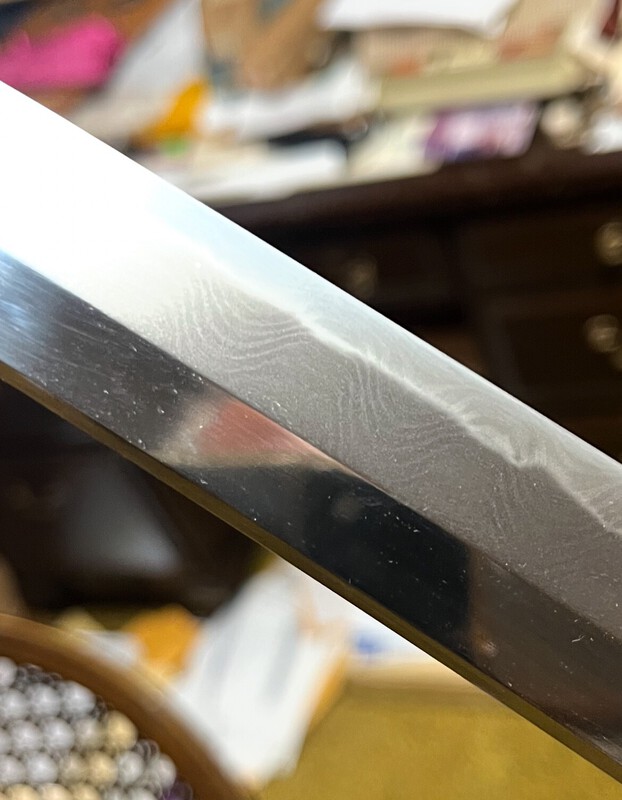
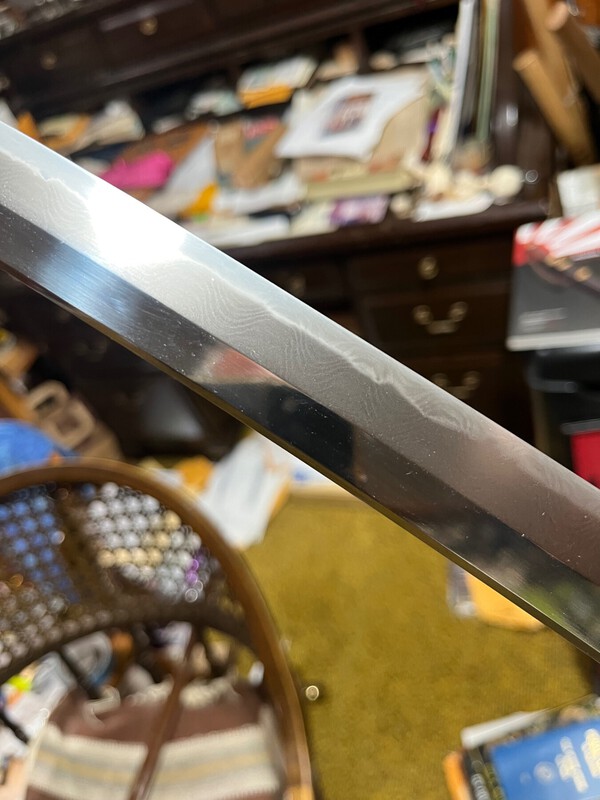
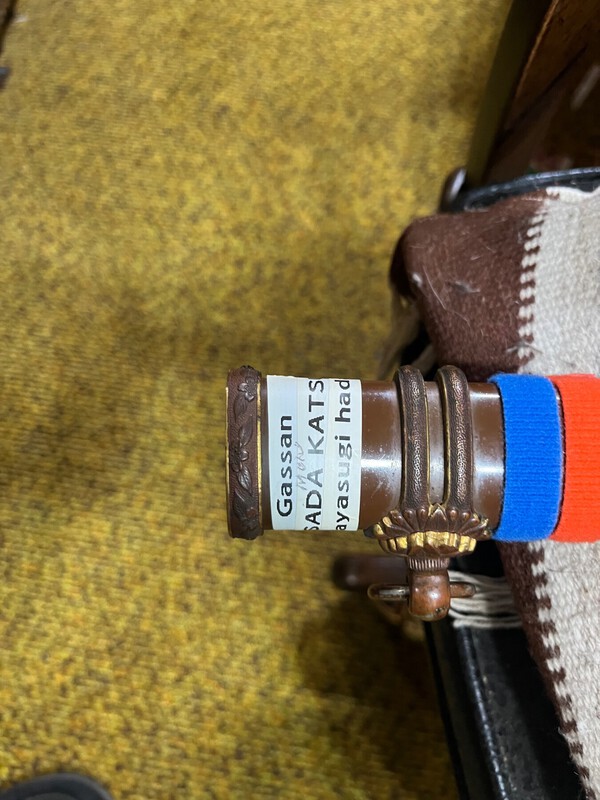
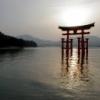





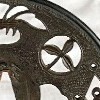
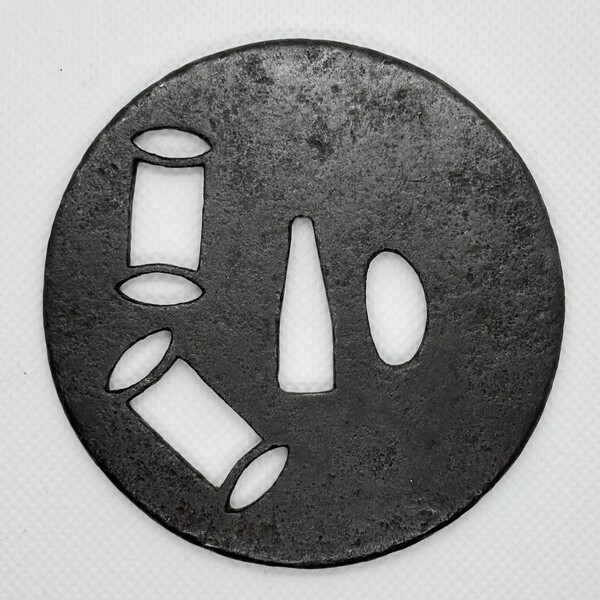


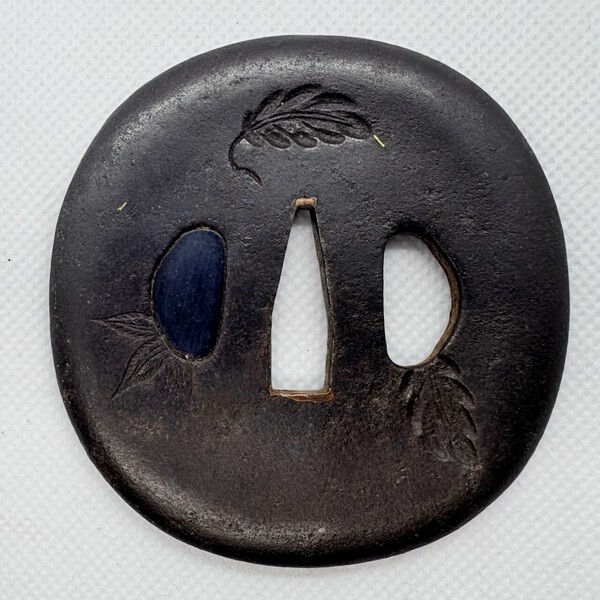
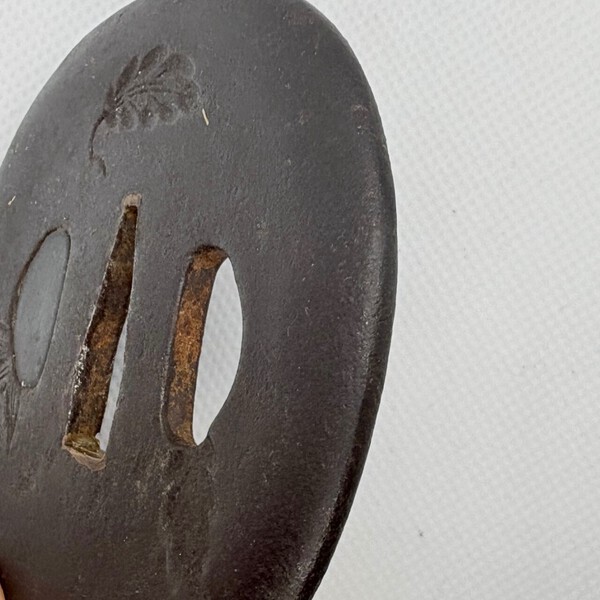



(1).thumb.jpg.a8668327b1cdb6a2ee40610c90c72c56.jpg)

